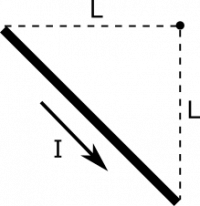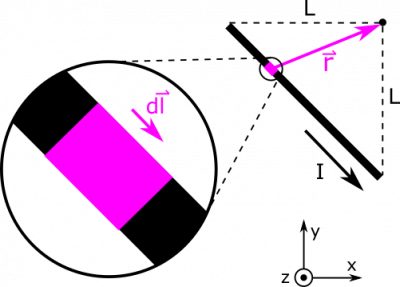This is an old revision of the document!
Magnetic Field from a Current Segment
The notes outline how to find the magnetic field from a very long wire of current. Now, what is the magnetic field from a single segment? Suppose we have the configuration shown below. Your observation point is at the origin, and the segment of current $I$ runs in a straight line from $\langle -L, 0, 0 \rangle$ to $\langle 0, -L, 0 \rangle$.
Facts
- The current in the segment is $I$.
- The observation point is at the origin.
- The segment stretches from from $\langle -L, 0, 0 \rangle$ to $\langle 0, -L, 0 \rangle$.
Lacking
- $\vec{B}$
Approximations & Assumptions
- The current is steady, and the wire segment is uniform.
Representations
- We represent the Biot-Savart Law for magnetic field from a current as
$$\vec{B}= \int \frac{\mu_0}{4 \pi}\frac{I \cdot d\vec{l}\times \vec{r}}{r^3}$$
- We represent the situation with diagram given above.
Solution
Below, we show a diagram with a lot of pieces of the Biot-Savart Law unpacked. We show an example $\text{d}\vec{l}$, and a separation vector $\vec{r}$. Notice that $\text{d}\vec{l}$ is directed along the segment, in the same direction as the current. The separation vector $\vec{r}$ points as always from source to observation.
For now, we write $$\text{d}\vec{l} = \langle \text{d}x, \text{d}y, 0 \rangle$$ and $$\vec{r} = \vec{r}_{obs} - \vec{r}_{source} = \langle 0,0,0 \rangle - \langle x, y, 0 \rangle = \langle -x, -y, 0 \rangle$$ Notice that we can rewrite $y$ as $y=-x-L$. This equation comes from the equation for a straight line, $y=mx+b$, where the slope of the line (or wire in this case) is $m=-1$ and the y-intercept of the wire is at $b=-L$. An alternate solution to this example could also be to rotate the coordinate system so that the x or y axis lines up with wire. If finding $y$ is troublesome, it may be helpful to rotate your coordinate axes.
If take the derivative of the line equation $y=-x-L$ then we can figure out how dx relates dy. 

